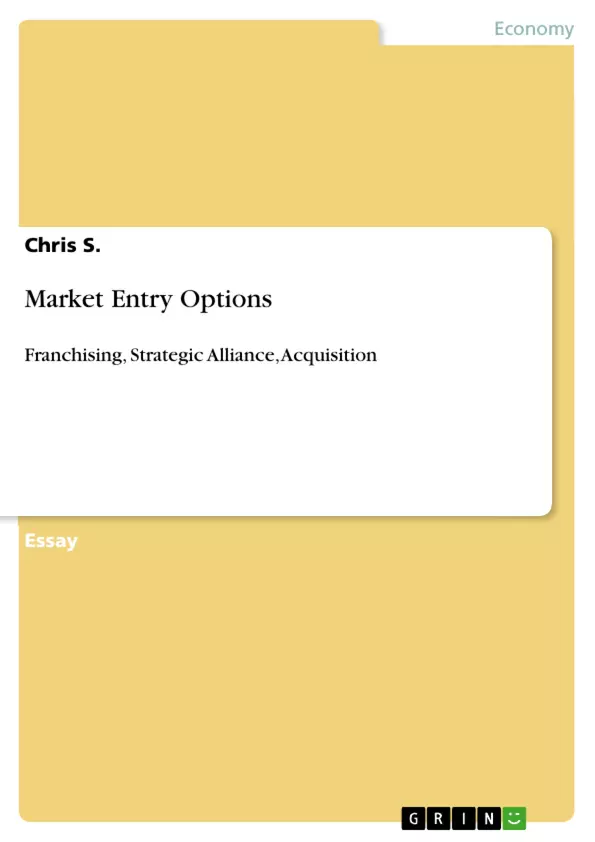FRANCHISING is a business system in which a company (or franchisor) sells an individual (or franchisee) the right to operate a business using the franchisor´s established system or format.
As part of the franchise agreement the franchisee pays an initial sum of money, a franchise fee or front end fee to the franchisor and agrees to pay a royalty or management service fee for continuing advice and assistance, which is usually calculated as a percentage of annual turnover. The franchisee may also pay an advertising fee to contribute to the franchisor´s annual advertising and marketing costs. The franchisee also has to find the capital to open the business. The franchisor provides an operations manual which contains all the information that the franchisee needs to run his or her business. Franchising exist across many different industries, but the most common are in the restaurant and food service industry.
Inhaltsverzeichnis (Table of Contents)
- Market Entry Options
- Franchising
- Strategic Alliance
- Acquisition
- Conclusion
Zielsetzung und Themenschwerpunkte (Objectives and Key Themes)
This text aims to provide a comprehensive overview of various market entry options for companies seeking to expand their businesses into foreign markets. The text explores the advantages and disadvantages of each option, using real-world examples to illustrate the concepts discussed. Key themes explored in the text include:- Franchising
- Strategic Alliances
- Acquisitions
- Market entry strategies
- International business expansion
Zusammenfassung der Kapitel (Chapter Summaries)
Market Entry Options
This chapter outlines various market entry options available to companies seeking to expand internationally. It provides a detailed explanation of franchising, strategic alliances, and acquisitions, highlighting their respective advantages and disadvantages. The chapter uses illustrative examples like Subway Restaurants in Germany, the Star Alliance, and Starbucks' acquisition of Seattle Coffee Company in the UK.Franchising
The chapter discusses the advantages of franchising for both the franchisor and the franchisee. It explores benefits like rapid business expansion, reduced investment requirements, and the ability to leverage the franchisee's resources. The chapter also highlights potential drawbacks, including the franchisor's loss of control over day-to-day operations and the risks associated with the franchisee's performance.Strategic Alliance
This chapter delves into the concept of strategic alliances, outlining their benefits, including market entry facilitation, shared costs and risks, and leveraging core strengths. It also addresses potential challenges like technology transfer, conflicting priorities, and the potential for relationship breakdowns. The Star Alliance serves as a real-world example of a successful strategic alliance.Acquisition
The chapter examines acquisitions as a market entry option, highlighting its benefits such as rapid market penetration and access to resources. However, it also discusses potential drawbacks like incompatible corporate cultures, increased financial risks, and difficulties in post-merger integration. Starbucks' acquisition of Seattle Coffee Company to enter the UK market provides a tangible example.Schlüsselwörter (Keywords)
The primary keywords and topics discussed in this text encompass franchising, strategic alliances, acquisitions, market entry strategies, international business expansion, advantages, disadvantages, examples, and real-world case studies. These terms represent the core concepts and research focus of the text.- Quote paper
- Chris S. (Author), 2008, Market Entry Options, Munich, GRIN Verlag, https://www.grin.com/document/135083



